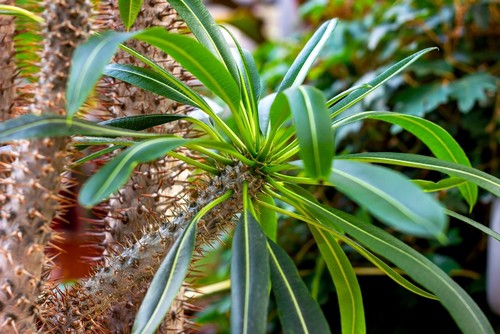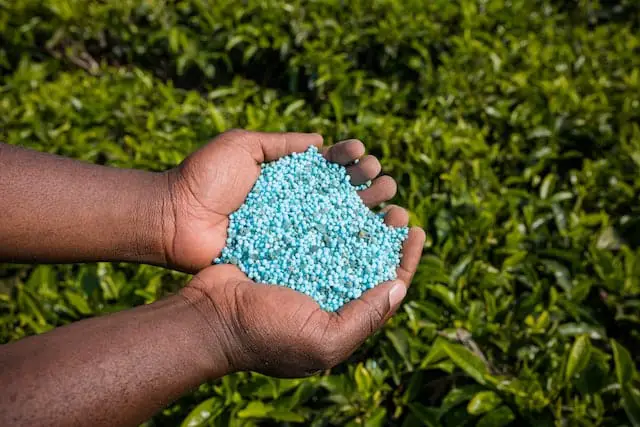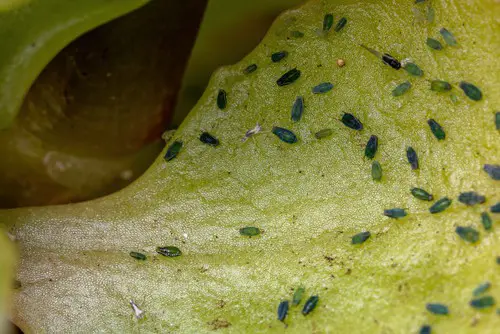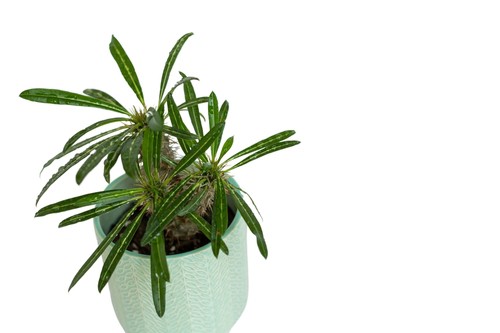Madagascar palms are beautiful and unique plants that can add a touch of the exotic to any home or garden. However, if you notice madagascar palm leaves turning yellow, it can be a cause for concern.
Yellowing leaves are a sign that something is wrong with your plant, and it is important to identify the cause and take action to prevent further damage.
Understanding Madagascar Palm is crucial in recognizing yellowing leaves. The Madagascar palm, also known as Pachypodium lamerei, is not related to true palms at all.
It is a succulent plant that is native to Madagascar and is known for its thick trunk and spiny leaves. While the Madagascar palm is a hardy plant that can survive in a variety of conditions, it is still susceptible to certain problems, including yellowing leaves.
There are several causes of yellow leaves on Madagascar palms, including overwatering, poor drainage, lack of nutrients, and pests. Fortunately, there are steps you can take to prevent and treat yellow leaves on your Madagascar palm.
By understanding the needs of your plant and taking the appropriate actions, you can help ensure that your Madagascar palm remains healthy and vibrant.
Key Takeaways
- Yellowing leaves are a sign that something is wrong with your Madagascar palm
- Overwatering, poor drainage, lack of nutrients, and pests are common causes of yellow leaves
- Preventing and treating yellow leaves involves understanding the needs of your plant and taking appropriate actions.
Also read:
- Dracaena Leaves Turning Yellow and Falling Off
- Lion’s Mane Mushroom Turning Yellow
- Lilac Leaves Turning Yellow
Understanding Madagascar Palm

Madagascar Palm, also known as Pachypodium lamerei, is a succulent plant that belongs to the Apocynaceae family. It is native to southern Madagascar and can grow up to 30 feet tall in the wild. However, when grown as an indoor plant, it usually reaches a height of 6-8 feet.
Madagascar Palm is often mistaken for a palm tree because of its thick trunk and long, green leaves that grow from the top. However, it is not related to palm trees and is actually a succulent. The plant is well-known for its unique appearance and is often used as a decorative plant in homes and gardens.
One of the common problems that Madagascar Palm owners face is yellowing of the leaves. This can be caused by several factors, including overwatering, underwatering, nutrient deficiencies, pests, and diseases. Therefore, it is essential to understand the plant’s needs and take proper care to prevent yellowing of the leaves.
When caring for Madagascar Palm, it is important to provide it with well-draining soil and water it sparingly. Overwatering can lead to root rot, which can cause yellowing of the leaves.
Similarly, underwatering can cause the leaves to turn yellow and fall off. Therefore, it is important to find the right balance and water the plant only when the soil is dry.
In addition to proper watering, Madagascar Palm also requires the right nutrients to grow healthy. A lack of nutrients, especially nitrogen and potassium, can cause yellowing of the leaves. Therefore, it is important to fertilize the plant regularly with a balanced fertilizer.
Lastly, pests and diseases can also cause yellowing of the leaves. Common pests that affect Madagascar Palm include mealybugs and spider mites, while diseases such as blight can also cause yellowing of the leaves.
Therefore, it is important to inspect the plant regularly and take appropriate measures to prevent and treat any pest or disease infestations.
Recognizing Yellowing Leaves
Madagascar palms are known for their striking appearance and vibrant green foliage. However, if you notice the leaves of your Madagascar palm turning yellow, it could be a sign of a problem. Here are some key things to look for when recognizing yellowing leaves:
- Color: The first and most obvious sign of yellowing leaves is the color change. The leaves will start to turn yellow, and the intensity of the yellow can vary. In some cases, the leaves may turn a pale yellow, while in others, they may turn a deep, golden yellow.
- Location: Pay attention to where the yellowing leaves are located on the plant. If the yellowing leaves are concentrated in one area or on one side of the plant, it could be a sign of a localized problem. If the yellowing is more widespread, it could be a sign of a larger issue.
- Texture: Yellowing leaves may also have a different texture than healthy leaves. They may feel softer or more limp, and they may be more prone to falling off the plant.
There are several potential causes of yellowing leaves in Madagascar palms, including:
- Lack of Light: Madagascar palms need a lot of light to grow well, and if they don’t get enough, their leaves may start to turn yellow. If the plant is not getting at least 4 hours of light per day, it could be the cause of the yellowing leaves.
- Overwatering: Overwatering is a common problem with Madagascar palms, and it can lead to yellowing leaves. If the soil is too wet or the plant is sitting in standing water, it can cause the roots to rot and the leaves to turn yellow.
- Nutrient Deficiencies: Madagascar palms require specific nutrients to thrive, and if they are not getting enough of these nutrients, it can cause the leaves to turn yellow. Common nutrient deficiencies include nitrogen, magnesium, and manganese.
If you notice yellowing leaves on your Madagascar palm, it’s important to identify the cause of the problem and take steps to correct it. By paying attention to the color, location, and texture of the yellowing leaves, you can get a better idea of what might be going on with your plant.
Madagascar Palm Leaves Turning Yellow – 6 Common Problems

Madagascar palms are hardy plants that can withstand a wide range of conditions. However, they are not immune to problems, and yellow leaves are a common issue.
There are several reasons why the leaves of a Madagascar palm may turn yellow, including inadequate light, improper watering, nutrient deficiency, pest infestation, diseases and fungus, and seasonal changes.
1. Inadequate Light
Madagascar palms require bright, indirect light to thrive. If the plant is not getting enough light, the leaves may turn yellow and drop off. On the other hand, too much direct sunlight can also cause yellowing and leaf burn. It’s important to find the right balance of light for your plant.
2. Improper Watering
Overwatering or underwatering can both cause yellow leaves on a Madagascar palm. If the soil is too wet, the roots can become waterlogged and start to rot, leading to yellowing and eventual death of the plant. On the other hand, if the soil is too dry, the plant may not be getting enough water, leading to yellow leaves and stunted growth.
3. Nutrient Deficiency
A lack of nutrients, particularly nitrogen and magnesium, can cause yellow leaves on a Madagascar palm. Nitrogen is essential for healthy leaf growth, while magnesium is necessary for the production of chlorophyll. If the plant is not getting enough of these nutrients, the leaves may turn yellow.
4. Pest Infestation
Pests like mealybugs and spider mites can cause yellow leaves on a Madagascar palm. These pests feed on the sap of the plant, causing damage to the leaves and eventually leading to yellowing and dropping off. Regular inspection and treatment can help prevent pest infestations.
5. Diseases and Fungus
Fungal diseases and infections can cause yellowing and wilting of the leaves on a Madagascar palm. These diseases can be caused by overwatering, poor drainage, or a lack of air circulation. Rot and blight can also cause yellowing and death of the plant.
6. Seasonal Changes
Madagascar palms may experience yellowing of leaves during seasonal changes, especially during the winter months. This is a natural response to changes in light and temperature, and the plant should recover once the season changes.
Madagascar Palm Care

Madagascar palms are hardy houseplants that can thrive with minimal care. However, they require specific conditions to remain healthy and avoid yellowing leaves. Here are some tips on how to care for your Madagascar palm:
1. Soil and Potting
Madagascar palms prefer well-draining soil that is mildly alkaline. Use a cactus compost mix or a blend of sand, perlite, and regular potting soil. Avoid using heavy clay pots that can retain excess moisture, leading to root rot. Instead, opt for plastic or ceramic containers with drainage holes.
2. Watering and Fertilizing
Madagascar palms are succulent plants that store water in their trunks. Therefore, they are drought-tolerant and can survive long periods without water. Water your Madagascar palm only when the top inch of soil is completely dry.
Overwatering can cause root rot and yellowing leaves. Fertilize your plant every two weeks with a balanced liquid fertilizer during the growing season (spring and summer) and reduce fertilization during the dormant season (fall and winter).
3. Light and Temperature
Madagascar palms need plenty of indirect sunlight to remain healthy. Avoid placing them in direct sunlight as it can scorch their leaves. Instead, place them near a south or west-facing window that receives plenty of light.
Madagascar palms prefer warm temperatures between 70°F to 80°F (21°C to 27°C) during the day and slightly cooler temperatures at night.
4. Pruning and Repotting
Madagascar palms rarely need pruning as they grow slowly. However, you can remove any yellow or brown leaves to improve the plant’s appearance. Repot your Madagascar palm every two to three years using fresh potting soil. You can propagate the plant using cuttings, offsets, or seeds.
By following these simple care tips, you can keep your Madagascar palm healthy and avoid yellowing leaves. Remember to provide well-draining soil, avoid overwatering, provide plenty of indirect sunlight, and repot every few years.
Prevention and Treatment of Yellow Leaves

Yellow leaves on a Madagascar Palm can be a sign of stress, disease, or other environmental factors. To prevent and treat yellow leaves, it is important to maintain healthy soil, proper moisture levels, and good drainage.
One way to prevent yellow leaves is by ensuring that the plant is potted in healthy soil. A well-draining soil mix that is rich in nutrients can help the plant thrive and avoid stress. It is also important to ensure that the soil is not too compacted, as this can cause the plant to wilt and yellow.
Another important factor to consider is moisture levels. Over-watering or under-watering can both cause yellow leaves. It is important to water the plant only when the top inch of soil is dry to the touch. It is also important to ensure that the pot has proper drainage holes to avoid waterlogging the soil.
If yellow leaves do occur, it is important to treat the underlying cause. This may involve adjusting the moisture levels, improving drainage, or treating a disease. For example, if the yellow leaves are caused by over-watering, the plant may need to be watered less frequently or repotted in a well-draining soil mix.
In addition to proper soil and moisture levels, it is important to ensure that the plant is healthy overall. This may involve providing adequate light, avoiding temperature extremes, and avoiding stress. Natural remedies, such as neem oil or a garlic spray, may also be effective in treating yellow leaves caused by disease or pests.
Additional Information
Yellowing leaves on a Madagascar palm can be caused by a variety of factors. Understanding the possible causes can help you diagnose and treat the issue.
1. Watering
Overwatering or underwatering can cause yellowing leaves on a Madagascar palm. If the soil is consistently wet, the roots may rot and the leaves will turn yellow and droop. On the other hand, if the soil is too dry, the leaves may also turn yellow and droop. It’s important to find the right balance of watering for your specific plant.
2. Nutrient Deficiency
A nutrient deficiency can also cause yellowing leaves on a Madagascar palm. In particular, a lack of nitrogen can cause yellowing of the leaves. If you suspect a nutrient deficiency, consider fertilizing your plant with a balanced fertilizer.
3. Light
Madagascar palms require bright, indirect light to thrive. If your plant is not receiving enough light, the leaves may turn yellow and droop. Consider moving your plant to a brighter location or providing supplemental light.
4. Pests

Pests such as spider mites, mealybugs, and scale insects can also cause yellowing leaves on a Madagascar palm. Check your plant for signs of pests, such as white spots or webbing. If you find pests, treat your plant with an appropriate insecticide.
5. Other Factors
Other factors that can cause yellowing leaves on a Madagascar palm include a dying or mature plant, exposure to toxic chemicals, and a trunk that is damaged or diseased. If you suspect any of these factors may be causing the issue, consult with a plant expert or arborist.
Frequently Asked Questions
Why are the leaves of my Madagascar Palm turning yellow?
Yellowing of Madagascar Palm leaves can be caused by a variety of factors, including overwatering, underwatering, lack of sunlight, nutrient deficiencies, pests, and diseases.
What causes yellowing of Madagascar Palm leaves?
Yellowing of Madagascar Palm leaves can be caused by a lack of nitrogen, which is essential for healthy leaf growth. Other factors that can cause yellowing include overwatering, poor soil drainage, and insufficient sunlight.
How can I prevent my Madagascar Palm leaves from turning yellow?
To prevent Madagascar Palm leaves from turning yellow, make sure the plant is getting enough sunlight, water the plant only when the top 1-2 inches of soil are dry, and fertilize the plant regularly with a high-nitrogen fertilizer.
Are yellowing leaves a sign of disease in Madagascar Palm?
Yellowing leaves can be a sign of disease in Madagascar Palm, but they can also be caused by environmental factors such as overwatering or nutrient deficiencies. If you suspect your plant has a disease, consult a professional for diagnosis and treatment.
What is the best fertilizer for a Madagascar Palm with yellowing leaves?
A high-nitrogen fertilizer is the best choice for a Madagascar Palm with yellowing leaves. Fertilize the plant every 2-3 weeks during the growing season, and reduce fertilization during the winter months.
Can overwatering cause Madagascar Palm leaves to turn yellow?
Yes, overwatering can cause Madagascar Palm leaves to turn yellow. Make sure the plant is not sitting in standing water, and water the plant only when the top 1-2 inches of soil are dry.

Hey, I’m Lisa and I’ve been an avid gardener for over 30 years. I love writing, talking and living in the garden! Feel free to connect with me on my socials below

